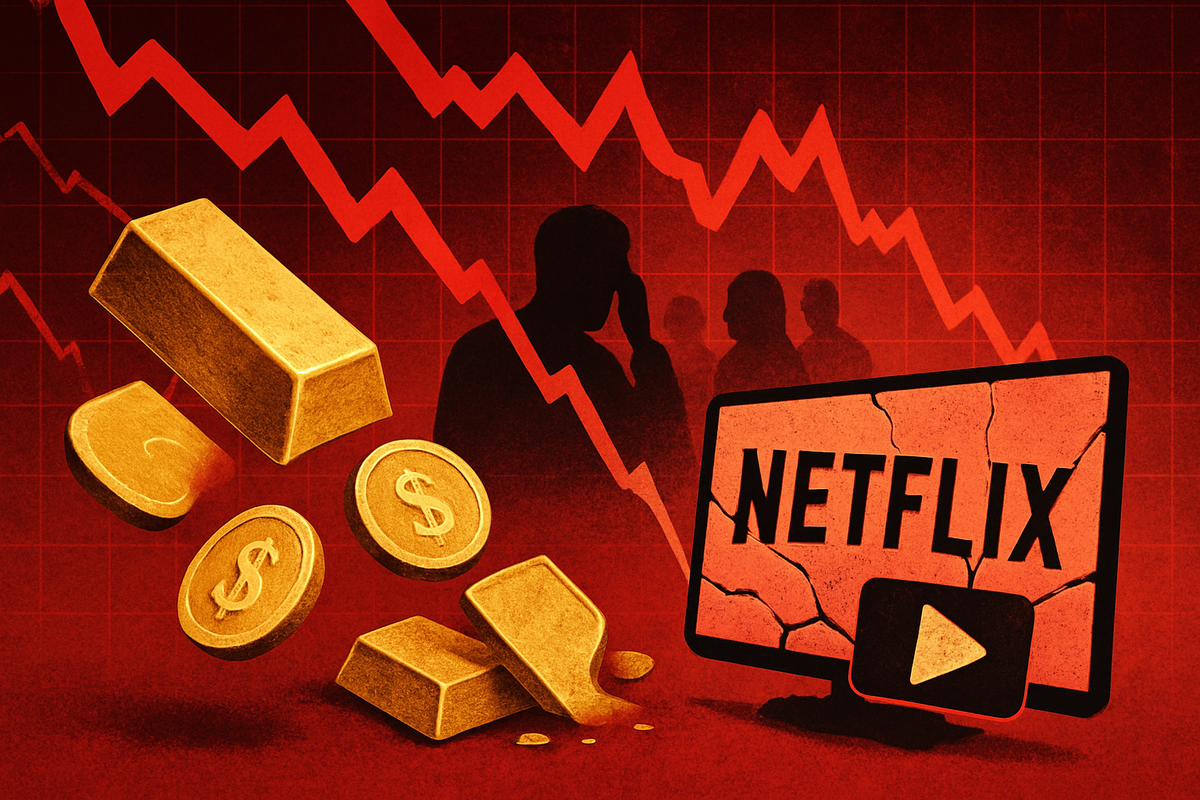
The United States stock market opened sharply lower on October 22, 2025, painting the major indices red and signaling a palpable increase in investor anxiety. This downturn was exacerbated by a notable dip in gold prices, traditionally a safe-haven asset, and a significant fall in the shares of streaming giant Netflix (NASDAQ: NFLX). The confluence of these events suggests a market grappling with renewed economic uncertainties and a re-evaluation of growth prospects in a tightening financial landscape.
The immediate implications for the market are heightened volatility and a clear shift towards risk aversion. Investors appear to be pulling back from riskier assets, seeking clarity amidst a complex web of economic indicators and corporate performance concerns. This cautious sentiment is setting the stage for a potentially turbulent trading day and raises questions about the market's trajectory for the remainder of the year.
Detailed Market Unrest and Catalysts
The session commenced with the S&P 500, Dow Jones Industrial Average, and Nasdaq Composite all registering significant losses shortly after the opening bell. This broad-based decline reflected a market reacting to a series of unsettling signals that have been accumulating. Leading up to this morning's open, several factors contributed to the pessimistic outlook. Whispers of higher-than-expected inflation figures from recent economic reports, coupled with weaker employment data, have fueled fears of an economic slowdown. Additionally, disappointing Purchasing Managers' Index (PMI) data hinted at contractions in key manufacturing and services sectors, further dampening investor confidence.
Simultaneously, the price of gold, which often acts as a hedge against inflation and market instability, surprisingly dipped. This counterintuitive move suggests a potential flight to the U.S. dollar, which strengthened, making gold more expensive for international buyers, or perhaps a liquidity crunch forcing some investors to sell even their safe-haven assets. The dip in gold also points to rising real interest rates, making non-yielding assets less attractive.
Adding to the market's woes, Netflix (NASDAQ: NFLX) experienced a substantial drop in its stock price. This decline is largely attributed to pre-market analyst downgrades citing concerns over subscriber growth deceleration and intensifying competition in the streaming sector. The company's content spending strategy and its ability to maintain average revenue per user (ARPU) are also under scrutiny, particularly in an environment where consumer discretionary spending might be tightening. The broader impact of higher interest rates on the valuation of growth stocks like Netflix further compounded its woes, as future earnings are discounted more heavily.
Companies Navigating the Storm
In this challenging market environment, certain companies are poised to experience significant impacts. Netflix (NASDAQ: NFLX) stands as a prominent loser, with its stock fall reflecting deep investor concern over its core business model metrics. The streaming giant's ability to attract and retain subscribers in an increasingly crowded market, alongside managing escalating content costs, remains a critical challenge. Competitors like Walt Disney (NYSE: DIS) and Warner Bros. Discovery (NASDAQ: WBD) will be closely watched, as Netflix's struggles could either signal broader industry headwinds or provide opportunities for rivals to gain market share if their strategies prove more resilient.
The dip in gold prices directly impacts gold mining companies such as Barrick Gold (NYSE: GOLD) and Newmont (NYSE: NEM). Lower gold prices directly translate to reduced revenues and potentially thinner profit margins for these producers. Silver mining companies, often correlated with gold, would also likely face similar pressures. Conversely, companies in defensive sectors, such as utilities (e.g., NextEra Energy (NYSE: NEE)) and consumer staples (e.g., Procter & Gamble (NYSE: PG)), might see increased investor interest as capital rotates away from riskier growth stocks. These companies, known for their stable earnings and dividends, often become attractive during periods of market uncertainty.
Wider Significance and Historical Context
This market downturn fits into broader industry trends marked by persistent inflationary pressures and a global shift towards tighter monetary policies. Central banks, including the Federal Reserve, have been aggressive in combating inflation, leading to higher interest rates that impact corporate borrowing costs and consumer spending. The streaming industry, once a high-growth darling, is now facing maturity challenges, including market saturation and intense competition, forcing companies like Netflix to innovate beyond simple subscriber acquisition.
The ripple effects of a red market open can extend far beyond the trading floor. A significant drop in stock values can erode consumer confidence, potentially leading to reduced discretionary spending and further slowing economic growth. Globally, such a downturn in the U.S. market can trigger sell-offs in interconnected international markets, particularly in economies reliant on U.S. consumer demand or investment. Historically, periods of rising interest rates combined with inflation concerns have often preceded market corrections, reminiscent of the early 2000s tech bubble burst or the inflationary periods of the 1970s, albeit with different underlying economic structures. The current scenario highlights the market's sensitivity to central bank policy and macroeconomic data.
What Comes Next: Navigating the Uncertainty
In the short term, investors should brace for continued market volatility as economic data releases and corporate earnings reports continue to shape sentiment. The upcoming weeks will be crucial for assessing whether this red open is an isolated event or the beginning of a more prolonged downturn. For Netflix, the immediate future will likely involve intensified scrutiny of its subscriber guidance and content investment returns. The company may need to pivot strategically, potentially focusing more on profitability over sheer subscriber volume, exploring new revenue streams, or even considering strategic partnerships.
For gold, a sustained dip could signal a shift in investor perception regarding inflation or the dollar's strength. However, if economic uncertainties deepen, gold's safe-haven appeal could quickly return, leading to a rebound. Long-term possibilities for the broader market include a potential "soft landing" if central banks manage to tame inflation without triggering a deep recession, or a more significant correction if economic fundamentals continue to deteriorate. Market opportunities may emerge in undervalued defensive stocks or companies demonstrating strong pricing power and resilient business models. Challenges will include navigating a potentially higher-for-longer interest rate environment and adapting to evolving consumer behaviors.
Comprehensive Wrap-Up
Today's red opening of the US stock market, marked by gold's dip and Netflix's fall, underscores a market grappling with a complex interplay of macroeconomic concerns and company-specific challenges. Key takeaways include the market's heightened sensitivity to inflation and interest rate policies, the maturing landscape of the streaming industry, and the evolving role of traditional safe-haven assets. The immediate future suggests continued caution and a close watch on incoming economic data, particularly inflation and employment figures, as well as the Federal Reserve's stance on monetary policy.
Moving forward, investors should anticipate a period of re-evaluation, where fundamental strength and resilience will be prioritized over speculative growth. The lasting impact of this period could be a recalibration of market valuations, particularly for growth-oriented technology stocks. Investors should monitor corporate guidance for signs of adapting to the current economic climate, central bank communications for clarity on future rate paths, and geopolitical developments for any unforeseen shocks. The market is signaling a need for prudence and strategic positioning in the months ahead.
This content is intended for informational purposes only and is not financial advice






